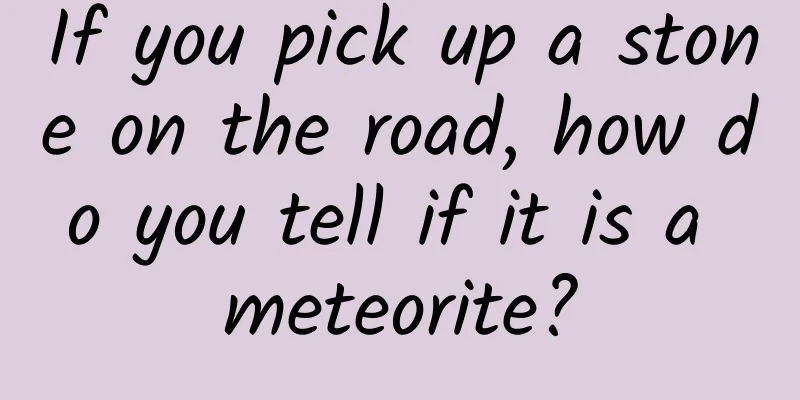If you pick up a stone on the road, how do you tell if it is a meteorite?

|
The price of a good quality stone on Earth can be driven up to the sky, but what about meteorites in the universe? Of course, they will be even more expensive. Ordinary meteorites can be sold for about $500 per gram, while rare meteorites are even more expensive. On October 5, 2010, Sotheby's in Paris auctioned a Namibian meteorite in Africa for a whopping $260,000. Meteorites, also called "meteors", are unburned stone, iron or stone-iron mixed materials that have broken away from the orbit outside the earth as cosmic meteors or dust fragments, and dropped these fragments onto the surface of the earth or other planets. Most meteorites come from the asteroid belt between Mars and Jupiter, and a small part comes from the moon and Mars. Meteors can be roughly divided into stone meteorites, iron meteorites, and mixed stone-iron meteorites. More than 40,000 meteorite samples have been collected in the world, and they come in various styles, such as stony meteorites mainly composed of silicates, iron meteorites mainly composed of iron-nickel alloys, and stony-iron meteorites composed of a mixture of iron and silicates. If you pick up a stone on the road, how do you tell if it is a meteorite? There are two ways to determine whether a stone is a meteorite: one is visual inspection, and the other is scientific testing. Let's focus on visual inspection below! Visual inspection method 1: magnet adsorption Today, the most important meteorites are stony meteorites, iron meteorites and stony-iron meteorites. No matter which type of meteorite, they all contain a lot of nickel and iron. To distinguish meteorites from stones, you can use a magnet to test. Iron meteorites and stony-iron meteorites have a high iron content, and magnets will firmly adhere to meteorites. Even in the least abundant meteorites, the nickel-iron content is close to 30%, which can easily attract magnets. There are also some meteorites that do not contain iron, such as Martian meteorites and lunar meteorites, but due to their relative rarity, they are temporarily ignored. Visual method 2: Look at the weight and density of the stone Iron meteorites weigh 8 grams per cubic centimeter, much heavier than ordinary rocks on Earth, and chondrites are also heavier because they contain a small amount of metal. A tennis ball-sized meteorite can weigh up to 5 pounds, so when you pick one up, pick it up and weigh it, and you may be able to tell the difference. Visual inspection method three: look at the fusion crust Meteorites that fall to the ground must pass through our thick atmosphere. When passing through the atmosphere, the friction of atmospheric pressure will produce a temperature of more than 3000 degrees Celsius, so the angular particles on the surface of the meteorite will be melted to form a thin layer of fusion crust. The surface color is black, relatively smooth, and has a streamlined feel. Visual inspection method 4: Look at the pellets Chondrites account for about 90% of all meteorites, and these meteorites contain a large number of millimeter-sized silicate spheres, which together with iron, nickel and other materials constitute meteorites, and chondrules can be seen on fresh sections of meteorites. Cut off a corner of a meteorite with a file and observe it with a magnifying glass. If you can see metal flakes and spherical silicate spheres, it may be a meteorite. If you think you have found a meteorite, try the four methods mentioned above. But after all, meteorites come from the universe, and our naked eyes can only be used as an auxiliary to identify them. To identify them 100%, you still need to find professionals and use professional equipment. What do you think about this? Welcome to leave a message in the comment area. Follow CHN Jiuxiang Technology, and through popular science, you will find that there are too many wonderful things in this world. |
<<: What is cockroach milk? Do you dare to try a cup?
Recommend
What are the effects and functions of raw Chuanwu
Chuanwu is one of the most important Chinese medi...
The efficacy and function of goosefoot root
Although Western medicine and Western drugs are m...
eMarketer: U.S. online grocery sales to approach $90 billion in 2020
Grocery e-commerce continues to grow as more cons...
What are the contraindications of Acanthopanax senticosus?
As competition in all walks of life in modern soc...
The efficacy and function of beautiful Lespedeza flowers
Many people are not very clear about the beautifu...
The efficacy and function of the ten great roots
The root of the Chinese magnolia vine is a common...
The efficacy and function of Alnus pubescens
Nowadays, our living standards are constantly imp...
Is Panax notoginseng effective in removing freckles?
Beauty and freckle removal is an important matter...
The efficacy and function of golden jelly
As the pressure of modern life increases, more an...
The efficacy and function of diamond thorn
Vajra thorn is a common Chinese medicine in clini...
The efficacy and function of neem
The Chinese herbal medicine Neem is a very good C...
Students can't eat snacks? The more nutrition you have, the taller you grow? Explain 8 misconceptions about student nutrition
Are foods labeled "children's food"...
The efficacy and function of Gentiana lutea
In modern life, everyone is very familiar with va...
Is anthocyanin stable?
If the human body can supplement more trace eleme...
Celebrities are also "afflicted" with this disease! Young people, don't ignore these symptoms
Expert of this article: Liu Chunxiu, Chief Physic...









